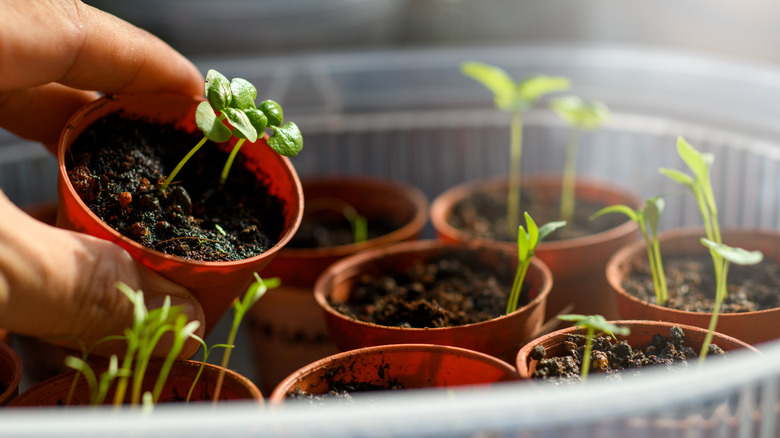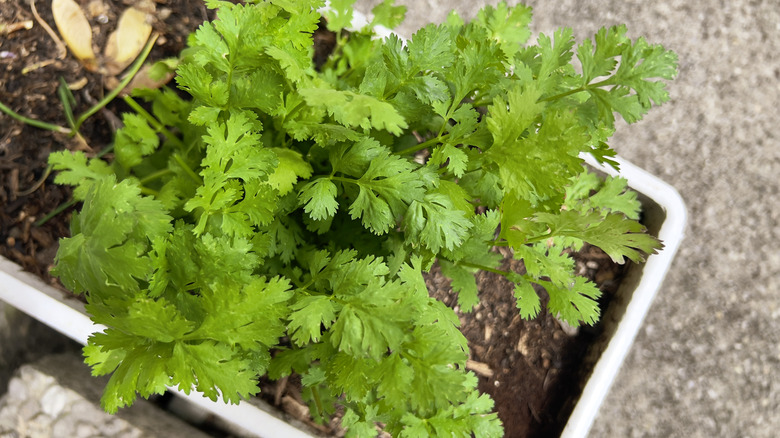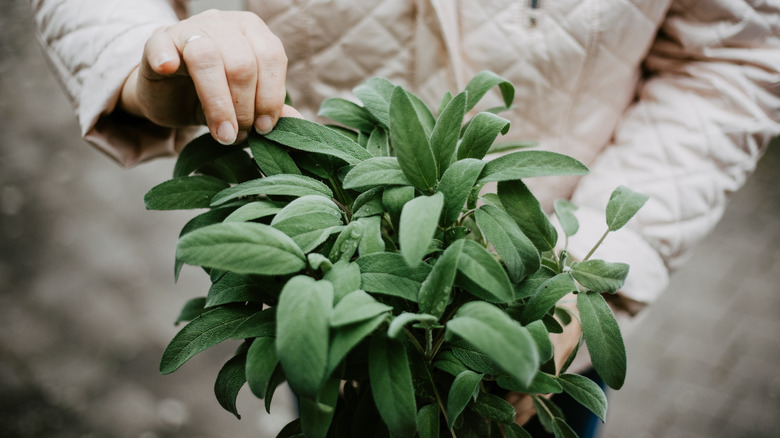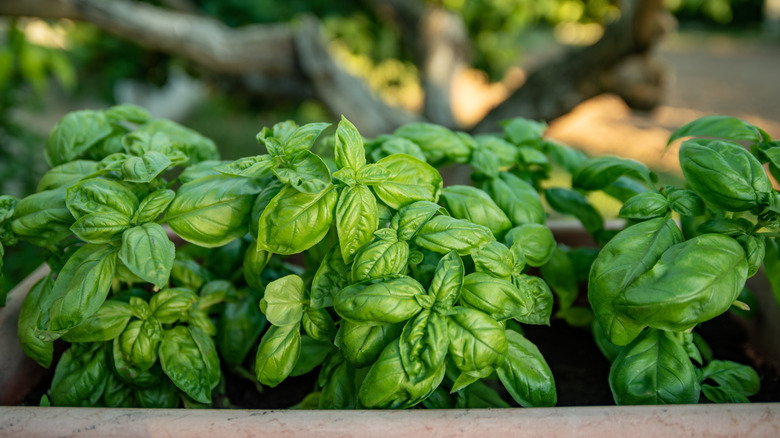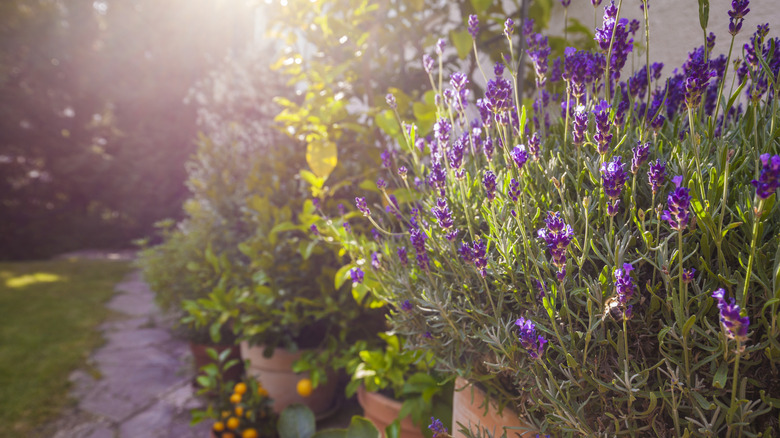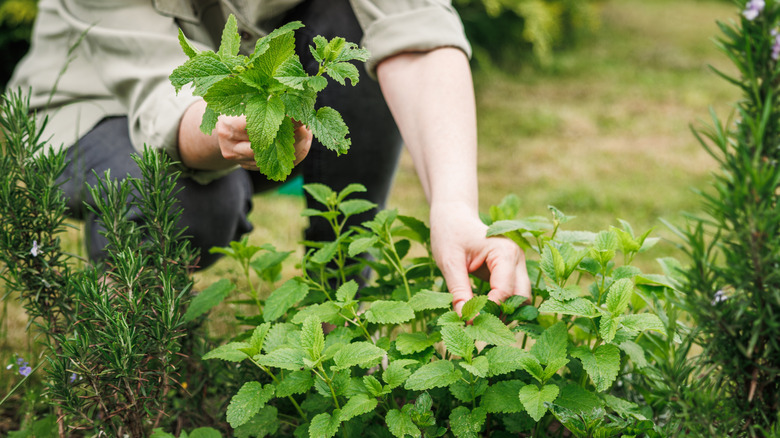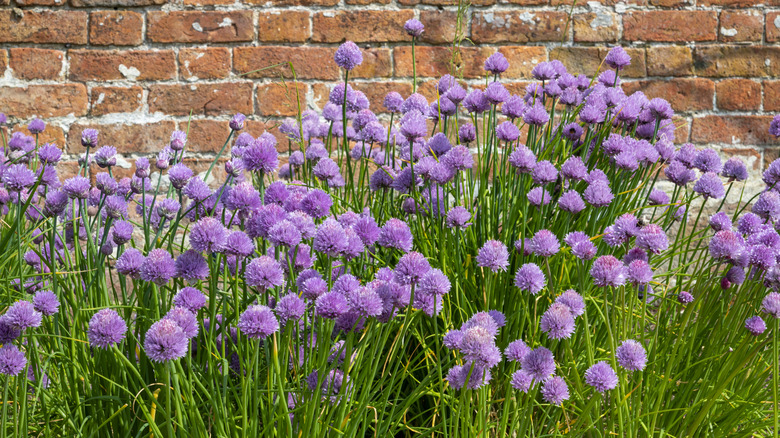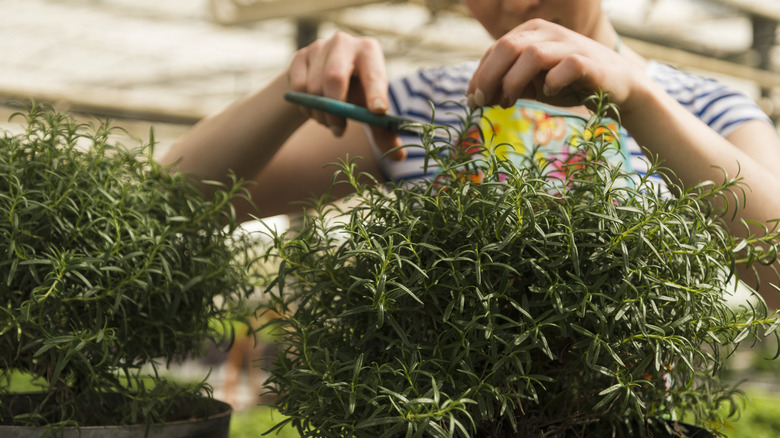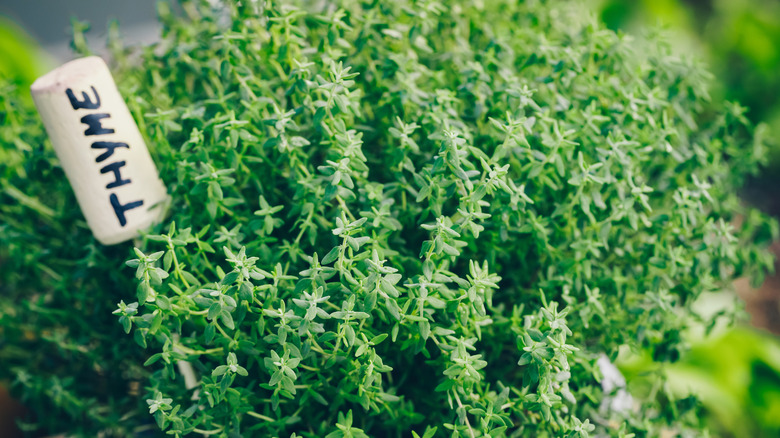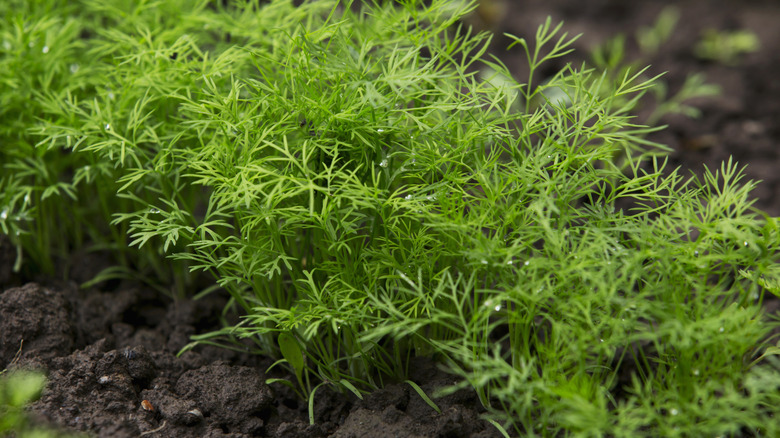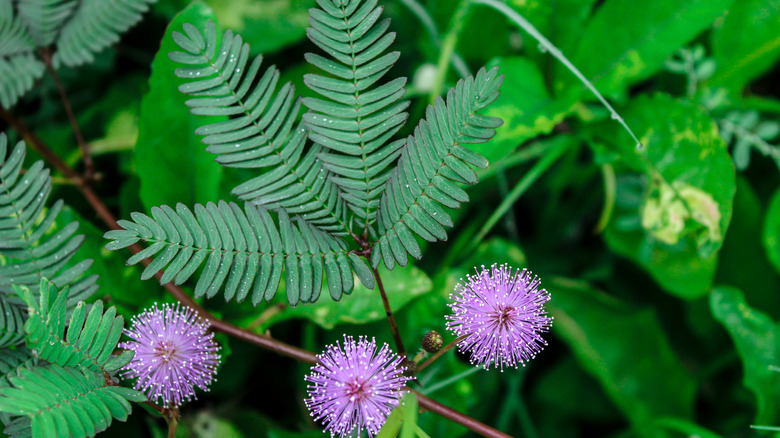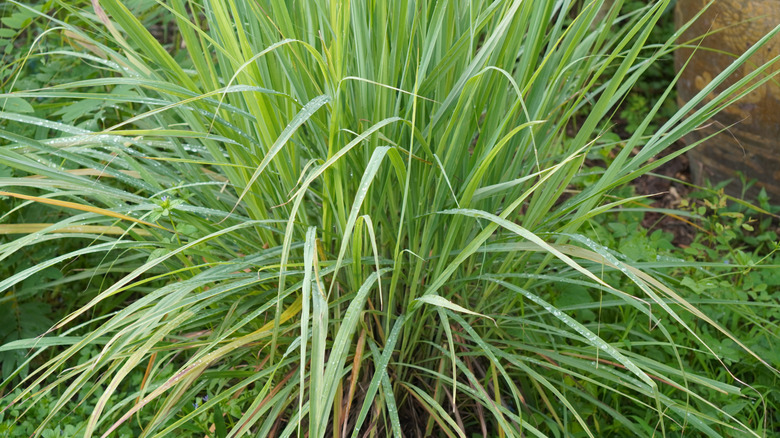The 12 Most Difficult Herbs To Grow In Your Garden
While, most of the time, herbs are the perfect plant to grow when you don't have a green thumb, some varieties can throw even the best gardener for a loop. Whether it's due to finicky soil preferences or moisture and sunlight necessities, some herbs are just not meant to tolerate anything outside of their optimal growing environment. Take sage, for example, an herb known to experience root rot if exposed to excessive moisture. Or cilantro, a temperature-sensitive plant notorious for bolting when it gets too warm. If the environment isn't just right, the herbs on this list can prove difficult to grow in your garden. Not to mention, some of these herbs may bring unwanted guests to your yard or become invasive if not handled properly.
However, if you avoid some of the biggest mistakes people make when growing herbs, like choosing the wrong variety for what suits your garden, and lean into the conditions of your yard and gardening habits instead, your herbs will reward you with beautiful, aromatic yields. Any number of these picky herbs could actually turn out to be your best crop yet if you commit to its proper care. On the other hand, if you find that these herbs sound too involved for what you're willing to do, it is best to skip them and opt for the easiest plants to grow for beginner gardeners.
Cilantro
A close cousin to parsley, cilantro (Coriandrum sativum) is a petite herb that only reaches about 1 foot in height, but despite its small size, many things can go wrong. First, cilantro bolts easily, meaning it rapidly grows flowers and seeds when it gets too warm. At that point, the leaves aren't particularly tasty. It's also very sensitive to heat and can dry out and die off easily. Though cilantro can be grown in a large range of hardiness zones spanning 2 to 11, try planting it during cooler months in the spring and fall to avoid bolting.
Sage
Sage (Salvia officinalis) is another herb that grows easily when you get its environment right. But, if you can't give it what it wants, it may just give up. It requires lots of sunlight, needs well-drained soil, and it very much dislikes overwatering. Hardy in zones 4 through 11, sage roots have a tendency to rot when exposed to too much moisture, which in turn facilitates mold growth. If you have all of that in line, though, it'll reward you with a nice 2 to 3-foot tall bush with sprays of beautiful violet flowers and aromatic leaves.
Basil
Basil (Ocimum) is another Goldilocks plant; it's only hardy in zones 10 to 11, and if it gets too cold, it can die off. But it'll bolt if it gets too warm, losing its aromatic flavor. While most of its herbal counterparts prefer well-drained soil and can tolerate even drought-like conditions, basil enjoys deep watering to retain enough moisture. How you harvest it also affects if it'll survive past your first picking and continue to grow. You'll want to cut above a leaf node, not just pick the leaves off, as beginners may initially be inclined to do.
Lavender
Unlike most other herbs on this list, lavender (Lavandula) prefers to grow in alkaline soil, preferring sandier or rockier ground in zones 5 to 11. Denser soil or clay is lavender's worst nightmare since it needs good drainage to thrive. In addition to drainage, it needs air circulation (particularly in humid weather) and loves sunlight (needing at least six hours daily). Lavender is also susceptible to bacteria infections, namely Xylella fastidiosa, a blight that kills a wide range of popular plants. If nurtured, though, this herb produces beautiful 2-foot-tall, aromatic, and vibrant flower stalks.
Mint
Mint (Mentha) is difficult to grow, not because it doesn't survive, but because it survives a little too well. An aggressive spreading plant that can be invasive if left unattended, mint grows a lot like bamboo, with underground runners facilitating spread. It will take over any garden bed if you plant it into the ground; however, if you love the idea of homemade mint tea, then be sure to firmly plant it in a container so that it stays put–generally, mint fares well in zones 3 to 8.
Chives
Chives (Allium schoenoprasum) is an herb that grows up to 12 inches in height and flowers with purple blossoms in early summer. It does well in the sun with only a little shade and can handle cooler temperatures. Where it gets difficult to grow is in maintaining soil composition. Chives respond very poorly to over-fertilization, and after harvest, the plants are known to exhibit weaker stalks. However, to strengthen the plant, you'll have to apply the right amount of fertilizer to prompt growth but not imbalance the soil and harm the chives. It's a bit of an herbal Catch-22!
Rosemary
Rosemary (Salvia rosmarinus) is an herb that, if you crack the code, will grow fairly easily in a garden, but if you upset its growing conditions and don't prune it, it can look quite sad. It does well in drought conditions, even faring decently in harsher terrain and poor soil. In optimal environments, rosemary grows up to 5 feet tall, but if you don't trim it, the shrub can start shedding, making it look skeletal. Rosemary doesn't survive in cold temperatures either, only being hardy in zones 8 to 11, and it can attract rosemary beetles and scale insects.
Thyme
Thyme (Thymus vulgaris) is a hardy, bushy, woody herb that grows in mounds up to a foot tall in hardiness zones 5 to 9. It prefers well-drained soil, can grow relatively well in colder weather, and is beautifully aromatic. However, thyme is known to lose out to weeds when faced with the challenge, particularly when grown from seed, so prepare yourself for consistent weeding sessions in the garden. This herb also does not tolerate excessive watering, so if you're in an area with constant rainfall, then your thyme may fail if not protected.
Dill
While dill (Anethum graveolens) can be considered easy to grow initially, it gets very sensitive in its environment and thus can be a little more tricky to maintain. Like sage, dill plants can rot if overwatered, preferring soil to fully get dry between waterings. It's also very sensitive to heat, like cilantro, bolting during warmer months and going to seed, thus losing its flavor. Unfortunately, this plant can also attract parsley worms that'll munch away at it, but on the plus side, they're larvae of the swallowtail butterfly! Expect plants up to 3 feet tall if taken care of.
Mimosa
Mimosa herbs (Mimosa pudica) is nicknamed the 'Sensitive Plant' for a reason — it's quite literally sensitive to the touch, and its leaves curl when it comes in contact with anything. Though it's native to the Caribbean and the American tropics, mimosa has been used in eastern medicines for ages. To grow mimosa, you'll need slightly acidic soil and commit to consistent watering. It does enjoy sunlight, but it's best to keep it in indirect light as heat can scorch the delicate leaves. Take caution, as mimosa also attracts pests like spider mites, aphids, and mealy bugs, too.
Tarragon
Tarragon (Artemisia dracunculus), a popular seasoning herb, is a spreader plant — like mint — that grows from underground rhizomes. It can grow up to 4 feet tall and should be divided every two to four years for healthy growth. Otherwise, it can compromise the herbs' vigor. This herb is another one that's susceptible to root rot if overwatered, so be sure to monitor moisture levels, and it can't stand over-fertilization. Tarragon's difficulty is not in its ability to grow but in how much maintenance and monitoring it needs for longevity.
Lemon grass
The lemon grass plant (Cymbopogon citratus) is a perennial that can grow up to 3 feet high and is hardy in zones 8 to 11. An advanced gardening plant and a popular ornamental addition to yards and gardens, it is rather difficult to harvest if you want to use it for cooking since the leaf blades are quite sharp. Lemon grass is also a sensitive plant, only thriving in full sun and really warm weather. Despite going dormant in winter, you shouldn't cut the grass back, but you'll need to protect it from the cold.
